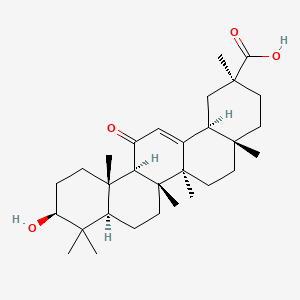| Authors | Title | Published | Journal | PubMed Link |
|---|---|---|---|---|
| Zhang H et al. | Structural basis for 18-β-glycyrrhetinic acid as a novel non-GSH analog glyoxalase I inhibitor. | 2015 | Acta Pharmacol. Sin. | pmid:26279158 |
| De Blasio BF et al. | Global, synchronous oscillations in cytosolic calcium and adherence in bradykinin-stimulated Madin-Darby canine kidney cells. | 2004 | Acta Physiol. Scand. | pmid:15030375 |
| Guo Y et al. | Inhibition of gap junction communication in alveolar epithelial cells by 18alpha-glycyrrhetinic acid. | 1999 | Am. J. Physiol. | pmid:10362727 |
| Ruiz-Meana M et al. | Persistence of gap junction communication during myocardial ischemia. | 2001 | Am. J. Physiol. Heart Circ. Physiol. | pmid:11356611 |
| RodrÃguez-Sinovas A et al. | Protective effect of gap junction uncouplers given during hypoxia against reoxygenation injury in isolated rat hearts. | 2006 | Am. J. Physiol. Heart Circ. Physiol. | pmid:16183732 |
| Lagaud G et al. | Inhibitors of gap junctions attenuate myogenic tone in cerebral arteries. | 2002 | Am. J. Physiol. Heart Circ. Physiol. | pmid:12427590 |
| Luksha L et al. | Endothelium-derived hyperpolarizing factor in preeclampsia: heterogeneous contribution, mechanisms, and morphological prerequisites. | 2008 | Am. J. Physiol. Regul. Integr. Comp. Physiol. | pmid:18032472 |
| Ikeda Y et al. | Role of gap junctions in spontaneous activity of the rat bladder. | 2007 | Am. J. Physiol. Renal Physiol. | pmid:17581924 |
| Niger C et al. | ERK acts in parallel to PKCδ to mediate the connexin43-dependent potentiation of Runx2 activity by FGF2 in MC3T3 osteoblasts. | 2012 | Am. J. Physiol., Cell Physiol. | pmid:22277757 |
| Shahidullah M et al. | TRPV4 in porcine lens epithelium regulates hemichannel-mediated ATP release and Na-K-ATPase activity. | 2012 | Am. J. Physiol., Cell Physiol. | pmid:22492652 |
| Veratti E et al. | 18beta-glycyrrhetinic acid and glabridin prevent oxidative DNA fragmentation in UVB-irradiated human keratinocyte cultures. | 2011 | Anticancer Res. | pmid:21737643 |
| Gupta P et al. | Antileishmanial effect of 18β-glycyrrhetinic acid is mediated by Toll-like receptor-dependent canonical and noncanonical p38 activation. | 2015 | Antimicrob. Agents Chemother. | pmid:25691644 |
| Long DR et al. | 18β-Glycyrrhetinic acid inhibits methicillin-resistant Staphylococcus aureus survival and attenuates virulence gene expression. | 2013 | Antimicrob. Agents Chemother. | pmid:23114775 |
| Papaevgeniou N et al. | 18α-Glycyrrhetinic Acid Proteasome Activator Decelerates Aging and Alzheimer's Disease Progression in Caenorhabditis elegans and Neuronal Cultures. | 2016 | Antioxid. Redox Signal. | pmid:26886723 |
| Seul KH et al. | Adenoviral delivery of human connexin37 induces endothelial cell death through apoptosis. | 2004 | Biochem. Biophys. Res. Commun. | pmid:15194487 |
| Fujino H and Regan JW | Prostaglandin F2alpha amplifies tumor necrosis factor-alpha promoter activity by the FPB prostanoid receptor. | 2004 | Biochem. Biophys. Res. Commun. | pmid:15094384 |
| Ransjö M et al. | Expression of connexin 43 mRNA in microisolated murine osteoclasts and regulation of bone resorption in vitro by gap junction inhibitors. | 2003 | Biochem. Biophys. Res. Commun. | pmid:12684060 |
| Griffith TM and Taylor HJ | Cyclic AMP mediates EDHF-type relaxations of rabbit jugular vein. | 1999 | Biochem. Biophys. Res. Commun. | pmid:10486252 |
| Matoba T et al. | Hydrogen peroxide is an endothelium-derived hyperpolarizing factor in human mesenteric arteries. | 2002 | Biochem. Biophys. Res. Commun. | pmid:11798159 |
| Moon MH et al. | 18β-Glycyrrhetinic acid inhibits adipogenic differentiation and stimulates lipolysis. | 2012 | Biochem. Biophys. Res. Commun. | pmid:22465130 |
18alpha-glycyrrhetinic acid
18alpha-glycyrrhetinic acid is a lipid of Prenol Lipids (PR) class. 18alpha-glycyrrhetinic acid is associated with abnormalities such as Wiskott-Aldrich Syndrome. The involved functions are known as inhibitors, salivary gland development and branching morphogenesis.
Cross Reference
Introduction
To understand associated biological information of 18alpha-glycyrrhetinic acid, we collected biological information of abnormalities, associated pathways, cellular/molecular locations, biological functions, related genes/proteins, lipids and common seen animal/experimental models with organized paragraphs from literatures.
What diseases are associated with 18alpha-glycyrrhetinic acid?
18alpha-glycyrrhetinic acid is suspected in and other diseases in descending order of the highest number of associated sentences.
Related references are mostly published in these journals:
| Disease | Cross reference | Weighted score | Related literature |
|---|
No disease MeSH terms mapped to the current reference collection.
PubChem Associated disorders and diseases
What pathways are associated with 18alpha-glycyrrhetinic acid
There are no associated biomedical information in the current reference collection.
PubChem Biomolecular Interactions and Pathways
Link to PubChem Biomolecular Interactions and PathwaysWhat cellular locations are associated with 18alpha-glycyrrhetinic acid?
There are no associated biomedical information in the current reference collection.
What functions are associated with 18alpha-glycyrrhetinic acid?
Related references are published most in these journals:
| Function | Cross reference | Weighted score | Related literatures |
|---|
What lipids are associated with 18alpha-glycyrrhetinic acid?
There are no associated biomedical information in the current reference collection.
What genes are associated with 18alpha-glycyrrhetinic acid?
There are no associated biomedical information in the current reference collection.
What common seen animal models are associated with 18alpha-glycyrrhetinic acid?
There are no associated biomedical information in the current reference collection.
